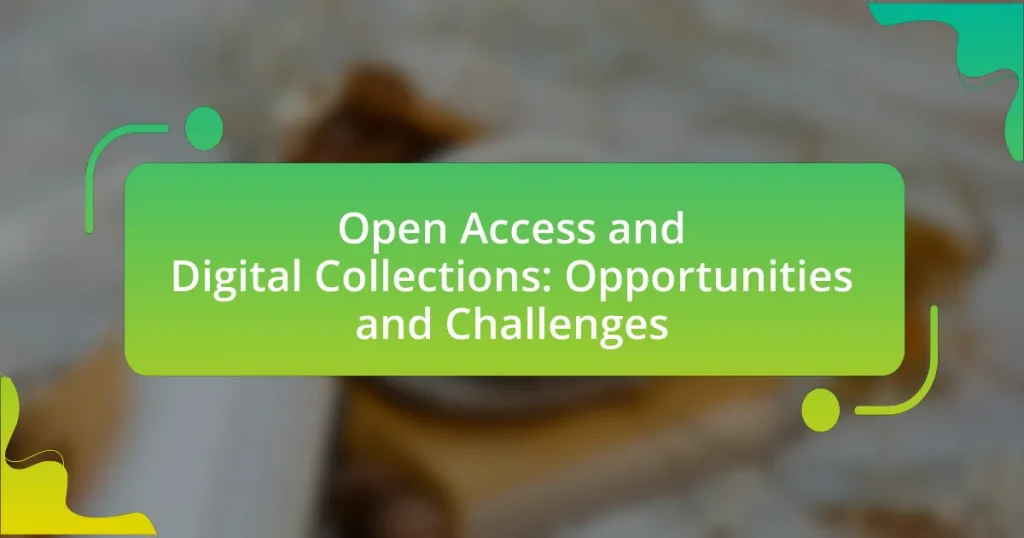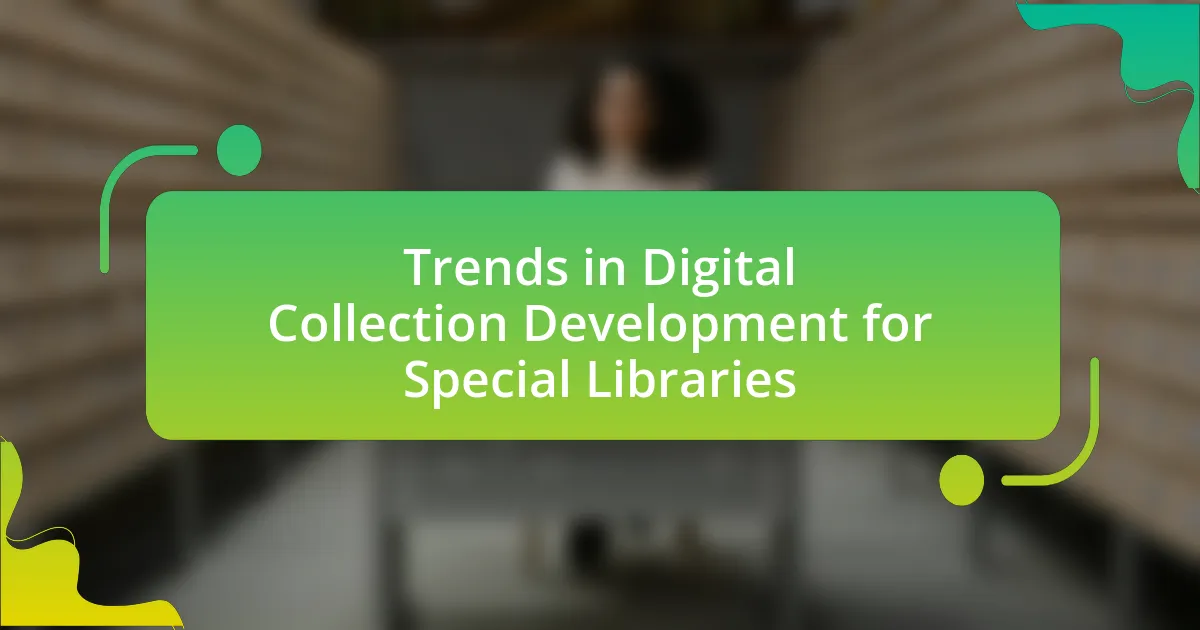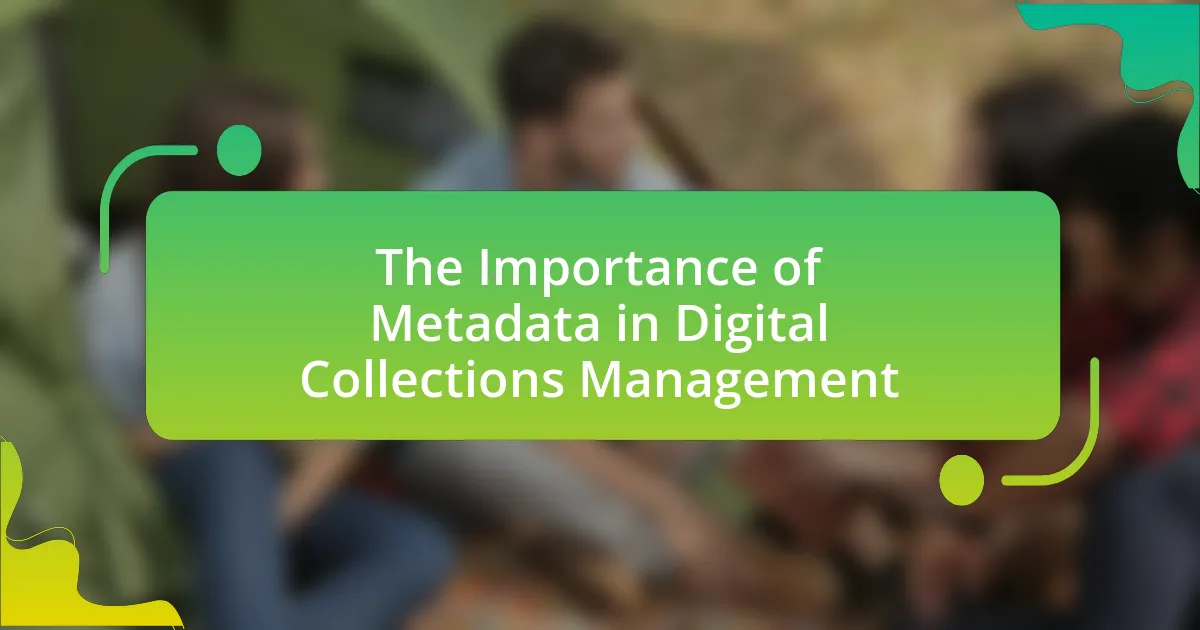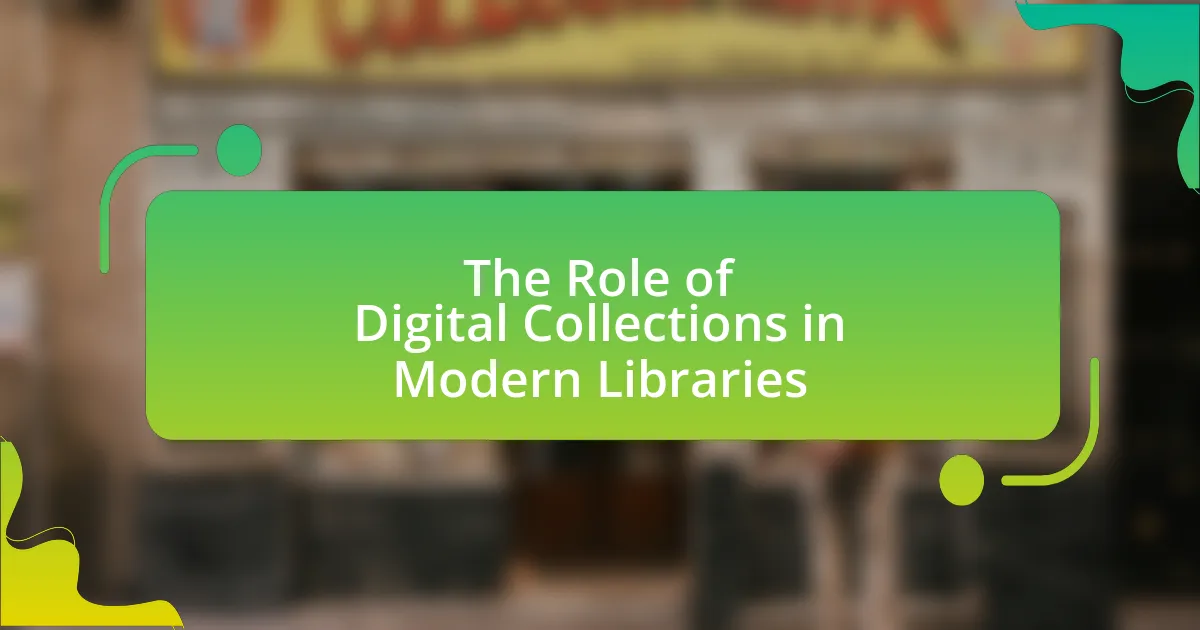Open Access and Digital Collections represent a transformative shift in the accessibility of scholarly research and cultural resources. Open Access allows unrestricted online access to academic work, eliminating financial barriers, while Digital Collections serve as curated repositories of digital assets, enhancing the visibility and usability of research materials. This article explores the differences between Open Access and traditional publishing models, the key characteristics of both concepts, their importance in today’s information landscape, and the challenges they face, including funding sustainability and copyright issues. Additionally, it highlights the opportunities these initiatives present for promoting collaboration, innovation, and the preservation of cultural heritage, as well as practical steps stakeholders can take to navigate the evolving landscape of Open Access and Digital Collections.

What is Open Access and Digital Collections?
Open Access refers to the unrestricted online access to scholarly research outputs, allowing anyone to read, download, and share academic work without financial or legal barriers. Digital Collections are curated repositories of digital objects, such as texts, images, and multimedia, that are often made available through Open Access to enhance visibility and accessibility of research materials. Together, Open Access and Digital Collections promote the dissemination of knowledge and facilitate collaboration among researchers, as evidenced by the growth of platforms like PubMed Central and arXiv, which provide free access to a vast array of scientific literature.
How do Open Access and Digital Collections differ from traditional publishing models?
Open Access and Digital Collections differ from traditional publishing models primarily in their accessibility and funding structures. Open Access allows free online access to research outputs, eliminating paywalls, while traditional publishing often requires subscriptions or one-time payments for access. Digital Collections, which aggregate and provide access to various digital resources, enhance discoverability and usability compared to traditional models that may limit access to physical copies or specific databases. According to a 2021 study by the Directory of Open Access Journals, Open Access articles receive 18% more citations than those behind paywalls, demonstrating the impact of accessibility on research dissemination.
What are the key characteristics of Open Access?
Open Access is characterized by the unrestricted online access to scholarly research outputs. This model allows users to read, download, and share research articles without financial, legal, or technical barriers. Key characteristics include the absence of subscription fees, the use of licenses that permit reuse and redistribution, and the commitment to making research publicly available immediately upon publication. According to the Budapest Open Access Initiative, which laid the groundwork for Open Access, this approach enhances the visibility and impact of research, facilitating greater collaboration and innovation in the academic community.
What defines Digital Collections in the context of Open Access?
Digital Collections in the context of Open Access are defined as curated groups of digital assets that are freely accessible to the public, enabling users to view, download, and utilize the materials without financial or legal barriers. These collections typically include a variety of formats such as texts, images, audio, and video, and are often hosted by libraries, archives, or educational institutions. The principle of Open Access ensures that these digital collections promote knowledge sharing and enhance research visibility, as evidenced by initiatives like the Budapest Open Access Initiative, which emphasizes the importance of unrestricted access to scholarly work.
Why are Open Access and Digital Collections important in today’s information landscape?
Open Access and Digital Collections are crucial in today’s information landscape because they enhance accessibility and democratize knowledge. By removing paywalls and providing free access to scholarly articles, research, and cultural artifacts, Open Access initiatives enable a broader audience, including researchers, students, and the general public, to engage with information that was previously restricted. According to a study published in the journal “PLOS ONE,” Open Access articles receive, on average, 18% more citations than their subscription-based counterparts, indicating that wider access leads to greater dissemination and impact of research. Furthermore, Digital Collections preserve and provide access to historical documents and cultural heritage, ensuring that diverse voices and perspectives are represented in the digital age. This combination of accessibility and preservation is essential for fostering innovation, collaboration, and informed decision-making in society.
How do they enhance accessibility to research and knowledge?
Open access and digital collections enhance accessibility to research and knowledge by removing paywalls and providing free online access to scholarly articles, data, and educational resources. This model allows a broader audience, including researchers, students, and the general public, to access high-quality information without financial barriers. According to a study published in PLOS ONE, open access articles are 18% more likely to be cited than those behind paywalls, demonstrating that increased accessibility leads to greater dissemination and impact of research findings.
What role do they play in promoting collaboration and innovation?
Open access and digital collections play a crucial role in promoting collaboration and innovation by providing unrestricted access to research outputs and resources. This accessibility fosters partnerships among researchers, institutions, and the public, enabling the sharing of knowledge and ideas across disciplines. For instance, studies have shown that open access publications increase citation rates, which enhances collaborative efforts and drives innovation in various fields. Furthermore, digital collections facilitate the integration of diverse datasets, allowing for interdisciplinary research that can lead to groundbreaking discoveries.
What challenges do Open Access and Digital Collections face?
Open Access and Digital Collections face several challenges, including funding sustainability, copyright issues, and technological barriers. Funding sustainability is critical as many Open Access initiatives rely on grants or institutional support, which can fluctuate. Copyright issues arise when determining the rights to share and distribute digital content, often complicating access for users. Technological barriers include the need for robust infrastructure to host and maintain digital collections, which can be costly and require ongoing technical expertise. These challenges hinder the growth and accessibility of Open Access and Digital Collections, impacting their effectiveness in disseminating knowledge.
What are the financial implications for institutions and researchers?
The financial implications for institutions and researchers include increased costs for publishing and maintaining open access platforms, as well as potential loss of revenue from traditional subscription models. Institutions often face higher expenses related to article processing charges (APCs) that researchers must pay to publish in open access journals, which can range from hundreds to thousands of dollars per article. Additionally, the shift to open access may lead to reduced funding for libraries and subscription-based resources, impacting their ability to provide comprehensive access to scholarly materials. According to a study by the European Commission, the transition to open access could result in a 20% increase in overall publishing costs for institutions, emphasizing the financial burden associated with this model.
How do copyright and licensing issues affect Open Access initiatives?
Copyright and licensing issues significantly impact Open Access initiatives by determining the legal framework within which research outputs can be shared and accessed. Open Access relies on the ability to freely distribute scholarly work, but traditional copyright laws often restrict this by granting exclusive rights to publishers. For instance, many journals require authors to transfer copyright upon publication, limiting the authors’ ability to share their work openly. This has led to the development of alternative licensing models, such as Creative Commons licenses, which allow authors to retain certain rights while permitting broader access. According to a study published in the journal “PLOS ONE,” approximately 60% of Open Access articles are published under some form of Creative Commons license, highlighting the shift towards more flexible licensing that supports Open Access goals. Thus, the interplay between copyright and licensing shapes the accessibility of research, influencing both the dissemination of knowledge and the sustainability of Open Access initiatives.
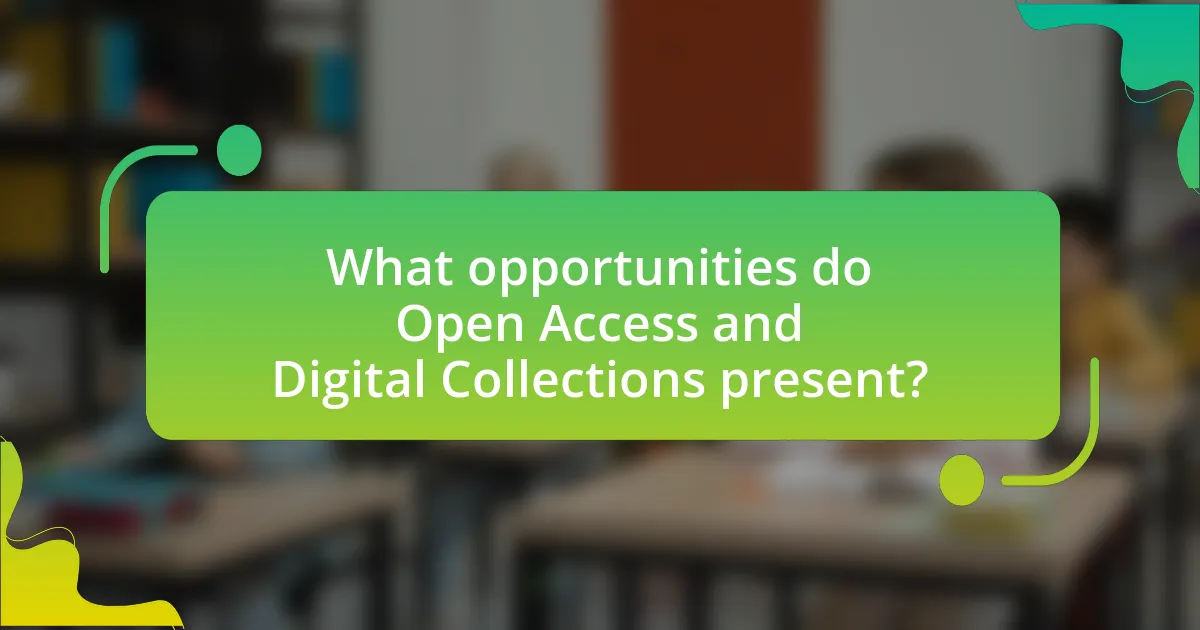
What opportunities do Open Access and Digital Collections present?
Open Access and Digital Collections present significant opportunities for increased accessibility and dissemination of knowledge. They enable researchers, students, and the general public to access scholarly articles, data, and cultural resources without financial barriers, thereby promoting equity in information access. For instance, studies show that Open Access articles are cited more frequently than their subscription-based counterparts, enhancing the visibility and impact of research. Additionally, digital collections facilitate the preservation and sharing of cultural heritage materials, allowing for broader engagement and collaboration across disciplines and communities. This democratization of information fosters innovation and supports lifelong learning.
How can Open Access improve the dissemination of research findings?
Open Access improves the dissemination of research findings by removing paywalls, allowing unrestricted access to scholarly articles for anyone, which significantly increases visibility and readership. Studies indicate that Open Access articles are cited more frequently than those behind paywalls; for instance, a 2016 study published in PLOS Biology found that Open Access articles receive, on average, 18% more citations than non-Open Access articles. This increased accessibility fosters collaboration among researchers, enhances public engagement with scientific knowledge, and accelerates the pace of innovation by making research findings available to a broader audience, including policymakers and practitioners.
What impact does Open Access have on citation and visibility of research?
Open Access significantly increases both the citation and visibility of research. Studies have shown that articles published in Open Access journals receive, on average, 50% more citations than those in subscription-based journals. For instance, a 2016 study published in PLOS ONE found that Open Access articles had a citation advantage of 18% to 25% compared to their closed-access counterparts. This increased visibility is attributed to broader accessibility, allowing researchers, practitioners, and the public to access and share findings without paywalls, thereby enhancing the dissemination and impact of research.
How do Digital Collections facilitate the preservation of cultural heritage?
Digital collections facilitate the preservation of cultural heritage by providing accessible, organized, and digitized records of artifacts, documents, and traditions. These collections enable the safeguarding of cultural materials against physical deterioration and loss, as they can be stored in multiple digital formats and backed up in various locations. For instance, the Library of Congress has digitized millions of items, ensuring that historical documents are preserved for future generations while also allowing global access. This approach not only protects cultural heritage but also promotes education and research, as users can engage with materials that might otherwise be inaccessible due to geographical or financial barriers.
What technological advancements support Open Access and Digital Collections?
Technological advancements that support Open Access and Digital Collections include cloud computing, digital repositories, and open-source software. Cloud computing enables scalable storage and access to vast amounts of digital content, facilitating the sharing of research outputs and educational resources. Digital repositories, such as institutional repositories and subject-specific archives, provide platforms for the preservation and dissemination of scholarly works, ensuring they are freely accessible. Open-source software, like DSpace and EPrints, allows institutions to create and manage their own digital collections without incurring high costs, promoting wider participation in Open Access initiatives. These advancements collectively enhance the visibility and accessibility of research, contributing to the growth of Open Access and Digital Collections.
How do digital platforms enhance user engagement and interaction?
Digital platforms enhance user engagement and interaction by providing interactive features such as comments, likes, and shares, which facilitate real-time communication among users. These platforms utilize algorithms to personalize content, ensuring that users receive relevant information that aligns with their interests, thereby increasing the likelihood of interaction. For instance, a study by the Pew Research Center found that 69% of adults in the U.S. use social media, which fosters community building and enhances user participation through shared experiences and discussions. Additionally, gamification elements, such as rewards and challenges, further motivate users to engage actively with the content.
What role does metadata play in the effectiveness of Digital Collections?
Metadata is crucial for the effectiveness of digital collections as it enhances discoverability, organization, and usability of digital assets. By providing structured information about the content, context, and format of digital items, metadata allows users to efficiently locate and access relevant materials. For instance, well-defined metadata standards, such as Dublin Core, facilitate interoperability across different systems, enabling seamless integration and sharing of resources. Furthermore, studies have shown that collections with comprehensive metadata experience higher user engagement and satisfaction, as users can easily navigate and retrieve information tailored to their needs.
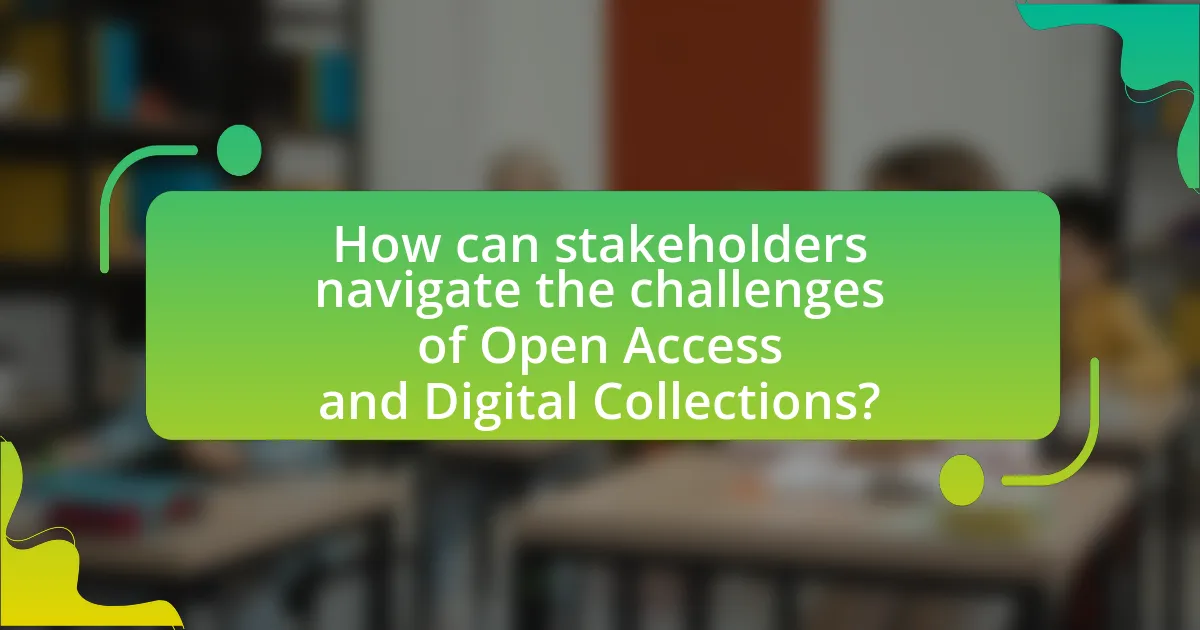
How can stakeholders navigate the challenges of Open Access and Digital Collections?
Stakeholders can navigate the challenges of Open Access and Digital Collections by implementing strategic collaborations, ensuring compliance with copyright laws, and utilizing sustainable funding models. Collaborative efforts among libraries, publishers, and researchers can enhance resource sharing and improve access to digital collections. Compliance with copyright laws is crucial, as it protects intellectual property while allowing for the dissemination of knowledge. Additionally, sustainable funding models, such as institutional support or grants, can provide the necessary financial backing to maintain and expand Open Access initiatives. These approaches are supported by the increasing trend of universities adopting Open Access policies, which facilitate broader access to research outputs and digital resources.
What strategies can researchers adopt to maximize the benefits of Open Access?
Researchers can maximize the benefits of Open Access by actively publishing in reputable Open Access journals and repositories. By choosing high-quality platforms, researchers ensure their work reaches a broader audience, increasing visibility and citation potential. According to a study published in PLOS ONE, articles in Open Access journals receive, on average, 18% more citations than those in subscription-based journals, demonstrating the tangible impact of Open Access on research dissemination. Additionally, researchers should engage in promoting their work through social media and academic networks, further enhancing accessibility and collaboration opportunities.
How can institutions support Open Access initiatives effectively?
Institutions can effectively support Open Access initiatives by implementing policies that mandate Open Access publishing for funded research. Such policies encourage researchers to publish their work in Open Access journals, increasing accessibility and visibility. For instance, the Wellcome Trust and the National Institutes of Health have successfully adopted similar mandates, resulting in a significant increase in the number of articles available through Open Access. Additionally, institutions can provide financial support for article processing charges, which often deter researchers from choosing Open Access options. By establishing institutional repositories, they can also facilitate the archiving and dissemination of research outputs, ensuring compliance with Open Access policies. These strategies collectively enhance the reach and impact of scholarly work while promoting a culture of openness in research.
What best practices should be followed for managing Digital Collections?
Best practices for managing digital collections include implementing robust metadata standards, ensuring regular backups, and providing user-friendly access interfaces. Metadata standards, such as Dublin Core, enhance discoverability and interoperability, facilitating easier search and retrieval of digital assets. Regular backups protect against data loss, with the National Digital Stewardship Alliance recommending a minimum of three copies stored in different locations. User-friendly access interfaces improve user engagement and accessibility, aligning with the principles of open access by making collections readily available to diverse audiences.
What are the future trends in Open Access and Digital Collections?
Future trends in Open Access and Digital Collections include increased adoption of open data policies, enhanced interoperability among digital platforms, and a shift towards community-driven content creation. The rise of open data policies is driven by institutions and governments aiming to promote transparency and accessibility, as evidenced by initiatives like the European Open Science Cloud, which encourages sharing research data across disciplines. Enhanced interoperability is facilitated by advancements in technology, allowing different digital collections to integrate seamlessly, thereby improving user experience and access to diverse resources. Additionally, community-driven content creation is gaining traction, as platforms like GitHub and Wikipedia demonstrate the value of collaborative contributions, leading to richer and more diverse digital collections. These trends reflect a broader movement towards democratizing access to information and fostering collaborative knowledge sharing.
How might policy changes impact the landscape of Open Access?
Policy changes can significantly reshape the landscape of Open Access by altering funding mechanisms, publication requirements, and access rights. For instance, the implementation of mandates that require publicly funded research to be published in Open Access formats can increase the volume of freely available scholarly articles, as seen in the European Union’s Horizon 2020 program, which emphasizes Open Access for funded research outputs. Additionally, changes in copyright laws can facilitate broader sharing and reuse of research, enhancing collaboration and innovation. Evidence from the 2016 U.S. National Institutes of Health policy shift, which expanded Open Access requirements, shows a marked increase in the number of articles available to the public, demonstrating that policy adjustments can directly influence the accessibility and dissemination of research findings.
What innovations are on the horizon for Digital Collections?
Innovations on the horizon for Digital Collections include advancements in artificial intelligence, enhanced user interfaces, and improved metadata standards. Artificial intelligence is expected to facilitate better content discovery and personalization, allowing users to find relevant materials more efficiently. Enhanced user interfaces will focus on accessibility and user experience, making digital collections more navigable and engaging. Improved metadata standards will ensure better organization and interoperability of digital assets, enabling seamless integration across platforms. These innovations are driven by the increasing demand for open access and the need for more effective digital resource management in libraries and archives.
What practical steps can be taken to enhance Open Access and Digital Collections?
To enhance Open Access and Digital Collections, institutions should implement policies that mandate the deposit of research outputs in open repositories. This approach increases visibility and accessibility of scholarly work. Additionally, providing funding for open access publication fees can incentivize researchers to publish in open access journals, thereby expanding the reach of their findings.
Furthermore, developing user-friendly digital platforms that facilitate easy navigation and searchability of collections can significantly improve user engagement. According to a study by the Scholarly Publishing and Academic Resources Coalition (SPARC), institutions that adopt these practices see a marked increase in the usage and citation of open access materials.
Lastly, fostering collaborations between libraries, researchers, and publishers can lead to innovative solutions that address barriers to access, ensuring a more inclusive and comprehensive digital landscape.
